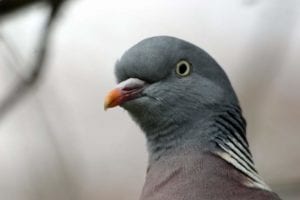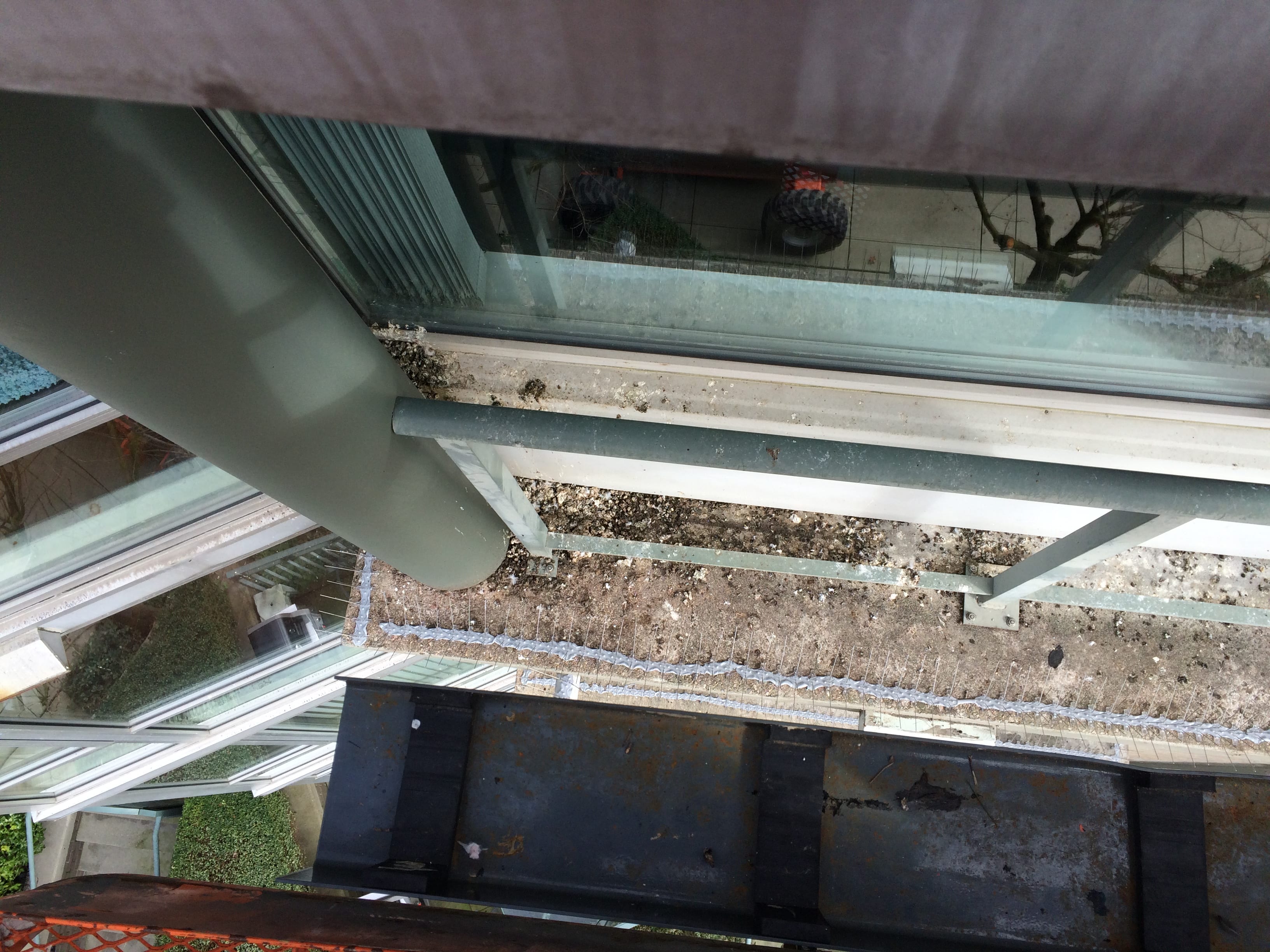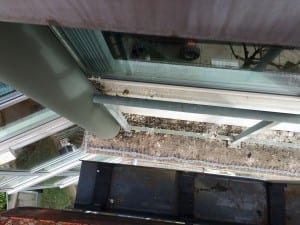
by Pigeon Patrol | Dec 16, 2019 | 4-S Gel Bird repellent, Animal Deterrent Products, Bird Netting, Bird Spikes, Pigeon Control, Pigeon Droppings, Pigeon Patrol's Services, Pigeon Spikes, Pigeons in the News
The Standing Policy Committee on Environment, Utilities and Corporate Services on Monday reviewed a report prepared in response to a request by Living Sky Wildlife Rehabilitation.
The centre asked the city to stop using the neurotoxin, saying it’s an inhumane way to control pests.
Around 2,300 pigeons put down, 635,000 kg of feces cleaned from Saskatoon bridge
According to a description on Avitrol’s website, the product works by causing “behaviours similar to an epileptic seizure.”
“This may include flying erratically, vocalizing, trembling, dilation of the pupils and other symptoms,” the description says.
Witnessing these behaviours can encourage unaffected birds to leave a location.
“Flocks can be frightened away from sites little or no mortality.”
According to the report, Avitrol is no longer used in other cities including Halifax, San Francisco and New York.
The committee heard how in the past the city used Avitrol to remove pests, but currently there are no sites where the city or its contractors are using the poison.
However the city does not have anything in writing that bans private use of Avitrol.
City hall to pursue pest management strategy for Saskatoon
Concern is raised over the city’s use of neurotoxins to control pigeon populations
PHIL TANK, SASKATOON STARPHOENIX
About Pigeon Patrol:
Pigeon Patrol Products & Services is the leading manufacturer and distributor of bird deterrent (control) products in Canada. Pigeon Patrol products have solved pest bird problems in industrial, commercial, and residential settings since 2000, by using safe and humane bird deterrents with only bird and animal friendly solutions. At Pigeon Patrol, we manufacture and offer a variety of bird deterrents, ranging from Ultra-flex Bird Spikes with UV protection, Bird Netting, 4-S Gel and the best Ultrasonic and audible sound devices on the market today.
Contact us at 1- 877– 4– NO-BIRD, (604) 585-9279 or visit our website at www.pigeonpatrol.ca
Bird Gone, Pigeon Gone, Pigeon problems, pigeon spikes, 1-877-4NO-BIRD, 4-S Gel, Bird Control, Pigeon Control, bird repellent, Bird Spikes, sonic bird repellent, stainless steel bird spikes, bird spikes Vancouver, Ultra Sonic Bird Control, Bird Netting, Plastic Bird Spikes, Canada bird spike deterrents, Pigeon Pests, B Gone Pigeon, Pigeon Patrol, pest controller, pest control operator, pest control technician, Pigeon Control Products, humane pigeon spikes, pigeon deterrents, pigeon traps, Pigeon repellents, Sound & Laser Deterrents, wildlife control, raccoon, skunk, squirrel deterrent, De-Fence Spikes, Dragons Den.

by Pigeon Patrol | Oct 16, 2019 | 4-S Gel Bird repellent, Animal Deterrent Products, Bird Deterrent Products, Bird Netting, Bird Spike, Bird Spikes, Pigeon Control, Pigeon Droppings, Pigeon Patrol's Services, Pigeon Spikes, Pigeons in the News

Dirtiest Hotel in America” Looks to Clean Up
A day after being dubbed the filthiest in America, a Tennessee hotel is pledging to clean up.
The Grand Resort Hotel & Convention Center was ranked the filthiest hotel in America, according to ratings compiled and released by the travel review site TripAdvisor.
The historic Smoky Mountains hotel in Pigeon Forge, Tenn., was graded “terrible” by 161 of 224 reviewers on the site. Twenty-six called it “poor” and 15 gave it an “average” grade.
But CEO and General Manager Nicky Darrell Chaney said he has already fired one manager, hired a new maintenance manager and new head of housekeeping, and is in the process of using a new sanitizer to clean the rooms, reports CBS affiliate WVLT in Knoxville.
“We knew we had some problems, and we’ve started to work on these problems,” said Nicky Chaney, President and CEO of the company that runs the hotel. Chaney took over operations in December and vows to restore their public image.
“I fired one of the managers, I hired new maintenance, and new housekeeper,” he said. “We’re proud of what we’re doing now, and were excited about where we’re going to be in the next few weeks.
Chaney took over just last month as president and CEO of KMS Enterprises, which runs the Grand and several nearby properties owned by hotel magnate Kenneth M. Seaton.
“This is an issue the company is taking very seriously,” Chaney said a statement Tuesday.
Seaton also is a defendant in a civil lawsuit alleging sexual harassment of two former housekeepers hired to work in KMS hotels, the Sentinel reports.
Meanwhile, the Grand will have to keep making changes to stay ahead of negative reviews – and the unwanted spotlight following the TripAdvisor “award.”
“This is a nasty place, would not let my dog sleep there,” reviewer LaFolettePat wrote last week under the headline “health inspector please.”
JordynC’s assessment: “If you are looking for a hotel with: pubic hair stuck to the bathroom floor in some unidentifiable, gelatinous liquid; chewing tobacco spit oozing down the halls and corridors; spiders actively making webs in every corner of your room; carpeting so greasy and dirty you wouldn’t want to sit your luggage down – let alone walk around barefoot; dingy bedsheets and towels as rough and thin as sandpaper; and a room so putrid and smelly it causes a gag-reflex when you walk in… by all means, stay at The Grand Resort.”
About Pigeon Patrol:
Pigeon Patrol Products & Services is the leading manufacturer and distributor of bird deterrent (control) products in Canada. Pigeon Patrol products have solved pest bird problems in industrial, commercial, and residential settings since 2000, by using safe and humane bird deterrents with only bird and animal friendly solutions. At Pigeon Patrol, we manufacture and offer a variety of bird deterrents, ranging from Ultra-flex Bird Spikes with UV protection, Bird Netting, 4-S Gel and the best Ultrasonic and audible sound devices on the market today.
Contact us at 1- 877– 4– NO-BIRD, (604) 585-9279 or visit our website at www.pigeonpatrol.ca
Bird Gone, Pigeon Gone, Pigeon problems, pigeon spikes, 1-877-4NO-BIRD, 4-S Gel, Bird Control, Pigeon Control, bird repellent, Bird Spikes, sonic bird repellent, stainless steel bird spikes, bird spikes Vancouver, Ultra Sonic Bird Control, Bird Netting, Plastic Bird Spikes, Canada bird spike deterrents, Pigeon Pests, B Gone Pigeon, Pigeon Patrol, pest controller, pest control operator, pest control technician, Pigeon Control Products, humane pigeon spikes, pigeon deterrents, pigeon traps, Pigeon repellents, Sound & Laser Deterrents, wildlife control, raccoon, skunk, squirrel deterrent, De-Fence Spikes, Dragons Den.

by Pigeon Patrol | Sep 17, 2019 | 4-S Gel Bird repellent, Animal Deterrent Products, Bird Deterrent Products, Bird Netting, Bird Spike, Bird Spikes, Pigeon Control, Pigeon Droppings, Pigeon Patrol's Services, Pigeon Spikes, Pigeons in the News, UltraSonic Bird Control

By Karoline Kan, CNN • 6th April 2019
Every day during the racing season, 55-year-old Zhang Yajun wakes at 4 a.m. and carefully loads bamboo cages containing his 76 cherished racing pigeons into a van. Then he drives up to 200 kilometers (124 miles) from his Beijing apartment to release them. They are in training for the October and November racing season, during which time millions of dollars can be won in total prize money across races.
Zhang is just one of some 100,000 pigeon breeders living in Beijing, according to Sun Yan, the deputy general-secretary of the Beijing Changping District Racing Pigeons Association.
“Pigeon racing is a culture, but it’s also a sport,” Sun says.
On a crisp fall morning, Zhang opens the cages in a cornfield at Niutuo in Hebei province, 80 km (50 miles) south of Beijing. Forty minutes later, he uses his phone connection to a rooftop camera to watch the birds arriving home. He’s happy with their speed.
Zhang, who was a state-owned beverage factory manager before retiring in the early 2000s, says he spends about 100,000 yuan ($14,900) a year on his pigeons. That covers food, medicine, race entry fees and transport costs for training sessions — as well as equipment such as his rooftop camera gear.
Each spring, Zhang says, some 100 pigeons are born on his roof but by fall only about 20 are left. The rest have either succumbed to illness or died of injuries suffered from hitting telegraph poles or other obstacles. Or else they just got lost on the way home.
But pigeon racing also has a darker side.
Zhang says “bird-napping” — when pigeons are baited and netted during training sessions before being sold off — is a common problem.
And then there is the cheating.
In April last year, two men hid their birds in milk cartons and caught a bullet train in Henan before releasing them in Shanghai, 750 km (466 miles) away. But the birds’ unusually fast speed aroused suspicion, and the men were fined and given suspended three-year prison sentences for fraudulently obtaining prize money totaling about $147,000.
However; Beijing is becoming less and less friendly to bird fanciers.
In the spring of 2017, under a city beautification campaign targeting two-story buildings in the lanes known as hutongs, many rooftop pigeon lofts were subsequently demolished.
The government classified them as illegal buildings.
Breeder Zhang Jian says four large pigeon cages on his roof were demolished, although he still surreptitiously keeps four other cages housing about 100 pigeons. Most of his neighbors have known Zhang Jian since he was a boy and he says they understand his passion for the birds.
About Pigeon Patrol:
Pigeon Patrol Products & Services is the leading manufacturer and distributor of bird deterrent (control) products in Canada. Pigeon Patrol products have solved pest bird problems in industrial, commercial, and residential settings since 2000, by using safe and humane bird deterrents with only bird and animal friendly solutions. At Pigeon Patrol, we manufacture and offer a variety of bird deterrents, ranging from Ultra-flex Bird Spikes with UV protection, Bird Netting, 4-S Gel and the best Ultrasonic and audible sound devices on the market today.
Contact us at 1- 877– 4– NO-BIRD, (604) 585-9279 or visit our website at www.pigeonpatrol.ca

by Pigeon Patrol | Aug 25, 2019 | 4-S Gel Bird repellent, Animal Deterrent Products, Bird Deterrent Products, Bird Netting, Bird Spike, Bird Spikes, Pigeon Control, Pigeon Droppings, Pigeon Patrol's Services, Pigeon Spikes, Pigeons in the News, UltraSonic Bird Control
![Pigeons have become the latest recruits in helping researchers gather data on climate change. Scientists at the University of Birmingham in the U.K. have developed a tiny set of sensors resembling a small backpack that can be strapped onto the back of pigeons. These little sensors help researchers collect data on urban microclimates ??? the fluctuations in temperature, humidity, and winds that can have major effects on living in major cities. So where do the pigeons come from? The group works with local volunteers who raise homing pigeons. Known for their abilities to return to their nest, homing pigeons have been used as far back as Ghengis Khan to carry messages across long distances. Using homing pigeons means that the researchers are sure to get their instruments back and can download the information before sending the birds on their way to collect more data. The design of the backpack conceived to keep the safety and comfort of the birds in mind. Each weighs less than 3 percent of the pigeon???s body weight, which is the standard for bird tracking devices. Thomas???s wife sewed each backpack, going through several versions until they found the perfect fit. ???If [the pigeon owners] are not happy with any aspect of putting the sensors on their back, then they don???t have to fly their birds,??? explains Rick Thomas, the research fellow who leads the study. ???The welfare of the birds is utterly paramount.??? Thomas also pointed out several good reasons to use birds rather than something like drone technology. For one, drones are not allowed to fly freely in any area, particularly after the trouble a drone caused at Gatwick airport in December. Secondly, different technology would not be as cost effective as what???s possible with the pigeons. Thus far, the group???s band of pigeons have logged over 620 miles with their backpacks over the course of 41 flights. The hopes are that the climate data can be used by scientists to help them predict how pollution](https://i0.wp.com/metro.co.uk/wp-content/uploads/2019/03/SEI_58347567.jpg?quality=90&strip=all&zoom=1&resize=540%2C405&ssl=1)
Pigeons are helping researchers gather data on climate change. (University of Birmingham/Cover Images)
Pigeons have become the latest recruits in helping researchers gather data on climate change.
Scientists at the University of Birmingham have developed a tiny set of sensors resembling a small backpack that can be strapped onto the back of homing pigeons. These little sensors help researchers collect data on urban microclimates, including fluctuations in temperature, humidity, and winds that can have major effects on living in major cities.
The pigeons themselves come from local volunteers that raise them and who agree to work with the scientists. Pigeons are helping researchers gather data on climate change.
Known for their abilities to return to their nest, homing pigeons have been used as far back as Ghengis Khan to carry messages across long distances. Using homing pigeons means that the researchers are sure to get their instruments back and can download the information before sending the birds on their way to collect more data.
The design of the backpack conceived to keep the safety and comfort of the birds in mind. Each weighs less than 3% of the pigeon’s body weight, which is the standard for bird tracking devices. Sensors in the backpacks help researchers collect data on urban microclimates (University of Birmingham/Cover Images)
‘If [the pigeon owners] are not happy with any aspect of putting the sensors on their back, then they don’t have to fly their birds,’ explains Rick Thomas, the research fellow who leads the study. The welfare of the birds is utterly paramount and, they’re not likely to cause the same issues as drones, explained Thomas.
The pigeons all come from local volunteer groups.![Pigeons have become the latest recruits in helping researchers gather data on climate change. Scientists at the University of Birmingham in the U.K. have developed a tiny set of sensors resembling a small backpack that can be strapped onto the back of pigeons. These little sensors help researchers collect data on urban microclimates ??? the fluctuations in temperature, humidity, and winds that can have major effects on living in major cities. So where do the pigeons come from? The group works with local volunteers who raise homing pigeons. Known for their abilities to return to their nest, homing pigeons have been used as far back as Ghengis Khan to carry messages across long distances. Using homing pigeons means that the researchers are sure to get their instruments back and can download the information before sending the birds on their way to collect more data. The design of the backpack conceived to keep the safety and comfort of the birds in mind. Each weighs less than 3 percent of the pigeon???s body weight, which is the standard for bird tracking devices. Thomas???s wife sewed each backpack, going through several versions until they found the perfect fit. ???If [the pigeon owners] are not happy with any aspect of putting the sensors on their back, then they don???t have to fly their birds,??? explains Rick Thomas, the research fellow who leads the study. ???The welfare of the birds is utterly paramount.??? Thomas also pointed out several good reasons to use birds rather than something like drone technology. For one, drones are not allowed to fly freely in any area, particularly after the trouble a drone caused at Gatwick airport in December. Secondly, different technology would not be as cost effective as what???s possible with the pigeons. Thus far, the group???s band of pigeons have logged over 620 miles with their backpacks over the course of 41 flights. The hopes are that the climate data can be used by scientists to help them predict how pollution](https://i2.wp.com/metro.co.uk/wp-content/uploads/2019/03/SEI_58347563.jpg?quality=90&strip=all&zoom=1&resize=540%2C719&ssl=1)
Drones are not allowed to fly freely in any area, particularly after the trouble a drone caused at Gatwick airport in December. What’s more, drone technology would not be as cost effective as what’s possible with the pigeons.
Thus far, the group’s band of pigeons have logged over 620 miles with their backpacks over the course of 41 flights. Impressive!
Read more: https://metro.co.uk/2019/03/25/scientists-recruited-pigeons-help-stop-climate-change-9008203
Have a Pigeon Problem?
Pigeon Patrol Products & Services is the leading manufacturer and distributor of bird deterrent (control) products in Canada. Pigeon Patrol products have solved pest bird problems in industrial, commercial, and residential settings since 2000, by using safe and humane bird deterrents with only bird and animal friendly solutions. At Pigeon Patrol, we manufacture and offer a variety of bird deterrents, ranging from Ultra-flex Bird Spikes with UV protection, Bird Netting, 4-S Gel and the best Ultrasonic and audible sound devices on the market today.
Voted Best Canadian wholesaler for Bird Deterrent products eight years in a row.
Contact us at 1- 877– 4– NO-BIRD, (604) 585-9279, or visit our website at www.pigeonpatrol.ca

by Pigeon Patrol | Aug 25, 2019 | 4-S Gel Bird repellent, Animal Deterrent Products, Bird Deterrent Products, Bird Netting, Bird Spike, Bird Spikes, Pigeon Control, Pigeon Droppings, Pigeon Patrol's Services, Pigeon Spikes, Pigeons in the News, UltraSonic Bird Control

Elisa Menendez – Wednesday 19 Jun 2019 9:56 PM
A woman has been fined £150 by her local council for feeding a piece of sausage roll to a pigeon. Sally-Ann Fricker fed the bird while shopping with her three children in Bath.
Her daughter, Toni Bradley, said they were approached ‘seconds later’ by an officer for littering, despite the pigeon flying away with the food.
Toni said: ‘If she’d chucked the wrapper down then that would have been fair enough, but this was absolutely ridiculous, we were very upset and very shocked.’
According to Bath and North East Somerset Council, those caught littering face a £150 fine, reduced to £100 if paid within 14 days.
Councillor Dave Wood, cabinet member for climate change and the environment, said the authority would review whether the fine was appropriate in this incident.
However, he added that there are notices on many streets asking the public not to feed pigeons as they are a ‘public nuisance’.
Daughter Toni was outraged at the fine, adding that her mum is a carer and the fine was worth more than her weekly earnings.
She said: ‘When I got home my three-year-old asked me to take down the bird feeder from the garden “because nanny got into trouble” for feeding them.’
Wood added that councils and their contractors should use ‘common sense’ with situations like Sally-Ann’s.
‘I have asked officers to urgently look into this matter and review the action taken with the contractor, to determine whether it was proportionate,’ he said.
He added: ‘As a general point, pigeons and gulls cause a public nuisance and are part of the problem the council has to manage when dealing with litter on the streets. ‘There are notices all over the city asking people not to feed birds.’
Read more: https://metro.co.uk/2019/06/19/mum-fined-150-feeding-sausage-roll-pigeon-10016074
Have a Pigeon Problem?
Pigeon Patrol Products & Services is the leading manufacturer and distributor of bird deterrent (control) products in Canada. Pigeon Patrol products have solved pest bird problems in industrial, commercial, and residential settings since 2000, by using safe and humane bird deterrents with only bird and animal friendly solutions. At Pigeon Patrol, we manufacture and offer a variety of bird deterrents, ranging from Ultra-flex Bird Spikes with UV protection, Bird Netting, 4-S Gel and the best Ultrasonic and audible sound devices on the market today.
Voted Best Canadian wholesaler for Bird Deterrent products eight years in a row.
Contact us at 1- 877– 4– NO-BIRD, (604) 585-9279, or visit our website at www.pigeonpatrol.ca








![Pigeons have become the latest recruits in helping researchers gather data on climate change. Scientists at the University of Birmingham in the U.K. have developed a tiny set of sensors resembling a small backpack that can be strapped onto the back of pigeons. These little sensors help researchers collect data on urban microclimates ??? the fluctuations in temperature, humidity, and winds that can have major effects on living in major cities. So where do the pigeons come from? The group works with local volunteers who raise homing pigeons. Known for their abilities to return to their nest, homing pigeons have been used as far back as Ghengis Khan to carry messages across long distances. Using homing pigeons means that the researchers are sure to get their instruments back and can download the information before sending the birds on their way to collect more data. The design of the backpack conceived to keep the safety and comfort of the birds in mind. Each weighs less than 3 percent of the pigeon???s body weight, which is the standard for bird tracking devices. Thomas???s wife sewed each backpack, going through several versions until they found the perfect fit. ???If [the pigeon owners] are not happy with any aspect of putting the sensors on their back, then they don???t have to fly their birds,??? explains Rick Thomas, the research fellow who leads the study. ???The welfare of the birds is utterly paramount.??? Thomas also pointed out several good reasons to use birds rather than something like drone technology. For one, drones are not allowed to fly freely in any area, particularly after the trouble a drone caused at Gatwick airport in December. Secondly, different technology would not be as cost effective as what???s possible with the pigeons. Thus far, the group???s band of pigeons have logged over 620 miles with their backpacks over the course of 41 flights. The hopes are that the climate data can be used by scientists to help them predict how pollution](https://i2.wp.com/metro.co.uk/wp-content/uploads/2019/03/SEI_58347563.jpg?quality=90&strip=all&zoom=1&resize=540%2C719&ssl=1)
